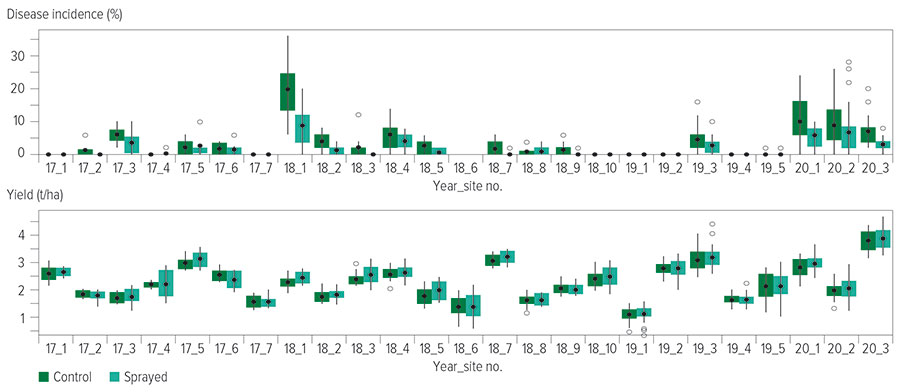Key points
- Sclerotinia Stem Rot (SSR) severity is primarily driven by environmental conditions
- Petal testing for Sclerotinia spores is not a reliable method of determining future SSR severity to inform spray decisions
- Seasonal environmental conditions and paddock history are the best assessment method for SSR risk and the need to spray
Research into the impact of Sclerotinia stem rot (SSR) on canola caused by Sclerotinia sclerotiorum fungal infection has raised questions about the disease severity prediction methodand infection level that leads to yield loss.
Between 2017 and 2020, 25 trials across WA conducted by the Centre for Crop and Disease Management at Curtin University with GRDC support, investigated fungicide application efficacy on canola varieties by trial site, from Moonyoonooka (north) to Mount Barker (south) and east to Corrigin.
Commonly grown open-pollinated, hybrid and Roundup Ready® canola varieties were grown, and treatments included unsprayed plots and plots sprayed with prothioconazole + tebuconazole generally at 30 per cent flowering.
Twenty two of the 25 locations received less than the long-term growing season rainfall and maximum daily temperatures were higher than average at all sites.
Findings
The potential SSR infection source and subsequent impact on canola production was systematically investigated throughout the growing season.
Soil samples prior to sowing showed sclerotia (the hard melanised structures of Sclerotinia that remain in the soil following harvest of infected crops) were unlikely to be the main infection source within a season, as few sclerotia were found.
Disease incidence was variable when ascospore presence on petals collected at 30 per cent flowering was high (more than 75 per cent), ranging from zero to 36 per cent. A high Sclerotinia ascospore presence on petals at this stage indicated potential for higher SSR infection but did not mean there will be higher infection. Petal assays were therefore a poor indicator of later disease severity.
Disease incidence was low across all four years, with 36 per cent the highest infection level recorded in a single plot in 2018 and high variability between plots within a site, with an average of less than 20 per cent (Figure 1). Significant differences in yield between the main treatments and interactions between management and site, and variety and site, were found, indicating SSR occurrence was primarily driven by the environment at each trial site.
Figure 1. Average Sclerotinia stem rot disease incidence (top, percentage) and canola yield (bottom) across 25 trial sites (2017-20) from unsprayed control plots and plots treated with fungicide at 30 per cent flowering.

Source: CCDM
Although at some sites fungicide management significantly decreased SSR, there were no significant differences in yield. At present, risk assessment for SSR infections remains most reliably determined by thorough knowledge of the seasonal environmental conditions and paddock history.
In 2021 trials, SSR percentage within a plot was simulated and yields recorded to determine the disease level required for yield loss. These results are being analysed to generate a yield loss curve for SSR in canola that will assist growers in determining the level of SSR infection resulting in yield loss and therefore economic spray thresholds.
More information: Associate Professor Sarita Bennett, 0457 898 199, sarita.bennett@curtin.edu.au
Read also: Sclerotinia Management App and scientific journal: Impact of Fungicide Application and Host Genotype on Susceptibility of Brassica napus to Sclerotinia Stem Rot across the South-Western Australian Grain Belt: A Genotype × Environment × Management Study

























































